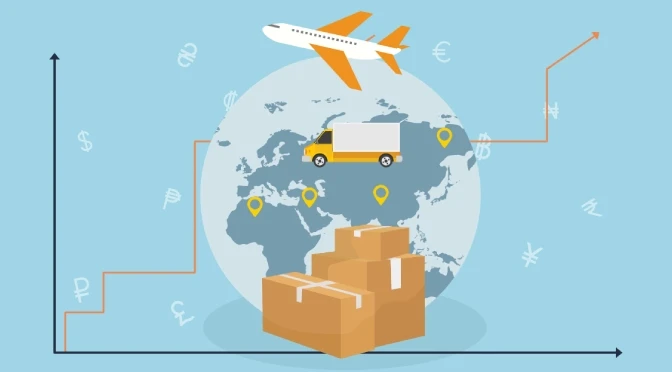Boost Profits by Shipping eCommerce Orders Internationally

There’s been a huge growth in international e-commerce lately, and if you’re looking to sell your products across borders, it’s a good way to increase profits. With about one in three online shoppers having purchased goods from other countries, it can open up a whole new market.
But there are numerous factors e-commerce businesses must consider before making that leap. As someone who’s operated businesses catering to an international clientele and who’s lived outside my home country for much of this century, I’d like to give you a few pointers on the logistics of global e-commerce.
Where to Ship
First, let’s look at where you’re going to sell. Those most likely to buy online internationally tend to live in Australia, Canada, or Russia. But don’t discount other markets in Asia – and particularly India – where year-on-year growth is increasing by 30% or more.
Asia also has marketplaces similar to Amazon and eBay, so it’s also easy to test how your products might fit into these markets. According to a study of global shoppers by Pitney Bowes, there are a number of barriers that contribute to abandoned shopping carts, the bane of all e-commerce shops. These include:
- Not offering a preferred form of payment: 30%
- Product descriptions in foreign languages: 29%
- Not accepting credit cards: 27%
- Pricing not in buyer’s local currency: 25%
Additionally, from where you’re shipping contributes to international buyers purchasing from your company. The three most desirable countries from which to buy are:
- United States – 71%
- United Kingdom – 44%
- Germany – 39%
If you’re trying to sell from any of these countries, you immediately have an advantage.
It’s additionally important to understand why people buy internationally. The same study shows the reasoning behind purchasing from international vendors:
- Price – 61%
- Availability – 40%
- Quality – 30%
- Better selection – 30%
Additionally, the authenticity of an item was another top factor in the following countries:
- India – 36%
- China – 30%
- South Korea – 30%
- Russia – 22%
So, if you’re selling knock-off items, these countries might not be the best countries to which to sell. (As an aside, if you’re selling high-quality knock-offs, I know personally there’s a small but lucrative market for certain items in Cape Town, South Africa. Hit me up!)
Now, let’s take a quick look at the annual sales in various markets and the percentage of total retail sales e-commerce represents, according to Shopify:
1. China: $672 billion, representing 15.9% of retail
2. United States: $340 billion, representing 7.5% of retail
3. United Kingdom: $99 billion, representing 14.5% of retail
4. Japan: $79 billion, representing 5.4% of retail
5. Germany: $73 billion, representing 8.4% of retail
6. France: $43 billion, representing 5.1% of retail
7. South Korea: $37 billion, representing 9.8% of retail
8. Canada: $30 billion, representing 5.7% of retail
9. Russia: $20 billion, representing 2% of retail
10. Brazil: $19 billion, representing 2.8% of retail
These are the ten biggest markets for international e-commerce, so I’d highly recommend researching whether they’d be a good fit.

What to Ship
If you’ve had requests from international customers, there’s probably demand for that product in the country. Yet I’d still highly recommend researching what’s on offer, and to take a look at the competition wherever you’re targeting to grow sales.
Each of the following platforms sell to specific areas, so if you’re looking at selling to countries within these regions, check out competitors selling similar products:
- Alibaba: Sells mainly to businesses throughout Asia, and particularly China.
- Amazon India: Sells to customers throughout India.
- Flipkart: Sells to customers throughout India.
- Mercado Libre: Sells to customers throughout Latin America.
- Rakuten: Sells throughout Asia, and especially Japan, though it’s expanding outside of Asia as well.
- Snapdeal: Sells to customers throughout India.
- Taobao: Under Alibaba’s umbrella, it sells to customers throughout Asia, and China in particular.
There’s no point in trying to sell products someplace where there’s no market. This is where you’ll need to roll up your sleeves and do a bit of product-specific and country-specific research to see if there’s a match. If no one else is selling your product in a particular country, it’s likely there’s not enough demand to make it worthwhile.
Using Next Gen-Tech
According to Siva Saravanan of Wavestone US, the digital supply chain is at varying levels of maturity worldwide, which is a huge factor if you’re shipping across international borders. Businesses looking to sell internationally should investigate how jacked-up countries’ logistics are digital to help streamline sales and distribution planning.
Saravanan advises they “implement a digital application to automate data gathering, integrate with enterprise resource planning, and derive value from analytics.” In short, do your research before you start your global e-commerce empire. You need to ensure countries to which you want to sell can have the logistics to easily accommodate your merchandise.
More developed markets can focus on next-generation logistics. Digitized supply chains offer advantages that allow for more efficient shipping, including blockchain technology, augmented reality, machine learning, AI, Internet of Things, and another cutting-edge tech.
A survey by Navis found that 83% of global terminal customers expect to increase investment in artificial intelligence within the next three years, with participants listing AI as being considered for handling the following processes:
- equipment assignments (81%)
- decking systems (81%)
- recommended actions (69%)
- gate volumes predictions (59%)
- predicting vessel stowage (52%)
In this same survey, only 11% confirmed they’re already using AI in terminal operations.
One last thing, and don’t take this as an aside. While many businesses like to think that old school “signing with a handshake” or “my word is my bond” should be sufficient for most business transactions, don’t do this with your logistics service contract.
Don’t even consider it!
It doesn’t matter if your logistics company is on the other side of the world. Since the start of the millennia, electronic signatures have become as binding worldwide as those written on paper and signed with ink. You need to protect yourself and your reputation, especially if you’re a relatively unknown company operating internationally.

Branded Shipping: Packaging as Marketing
Now, for those who are thinking about shipping internationally, packaging might seem like the least important part of this. It’s not.
Look at this as part of your marketing. Clever shipping hacks can help build a loyal customer base and should be utilized as a branding opportunity.
By considering environmental, political, and technological aspects of the market to which you’re trying to sell, you can give your products an advantage over even local competitors.
Remember, it’s not about thinking short term, but longer term.
One particularly relevant topic doing the rounds on social media involves the unboxing experience. Consider using creative packaging. This doesn’t need to add much expensive. You can use custom labels with unusual fonts or coloring to stand out from the crowd.
Or perhaps include coupons, small product samples, personalized thank you cards, or promotional stickers that show how you’re different from competitors. Maybe even sneak a short survey – written in the customer’s native language – into the packaging. It’s like the thrill of opening a gift!
Author Bio: Since retiring from international business, D. A. Rupprecht has become an internationally-based freelance writer who writes about digital marketing, technology, and logistics. He also occasionally writes books.


